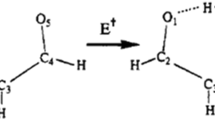Summary
-
1.
Theoretical calculations, the results of which have been given here briefly in qualitative fashion, have been made with the object of discovering the elementary (micro-scale) mechanism of a phenomenon. Being concerned with a micro mechanism, these calculations are in their essence quantum-mechanical calculations, and it is this circumstance that determines the most characteristic features of the theory developed. One such characteristic feature is that the theory must operate with simplified and schematized models with models that lend themselves to quantum-mechanical calculation. The fundamental features of the mechanism then become manifest in their clearest and least obscured form.
-
2.
Another characteristic feature is that, while attempting to explain experimentally observed regularities and to discover the possible source of these regularities, the theory leads us to completely new ideas and concepts which did not figure previously in theories of adsorption. This is again the result of the quantum-mechanical approach to the problem.
-
3.
Finally, for the theory of chemisorption, developed from this aspect, as has been done here, it is characteristic that its basis is the modern theory of solids and that it utilizes the concepts and apparatus of the modern theory of solids. The entry of the theory of solids into the adsorption and catalysis field, i.e., into the territory of physical chemistry, is necessary and inevitable for the creation of a micro-scale theory of chemisorption. The theory of chemisorption, of course, is still not a theory of catalysis, but it forms the first step in the direction of the creation of a theory of catalysis: its ideas and concepts form: the. foundation on which a theory of catalysis may be built.
Similar content being viewed by others
Literature Cited
F. F. Volkenshtein, Bull. Acad. Sci. USSR, Div. Chem. Sci., No. 5, 788 (1953).(See C. B. Translation, p.701).
F. F. Volkenshtein, J. Phys. Chem., 23, 917 (1949).
F. F. Volkenshtein, Problems of Kinetics and Catalysis, 7, 360 (1949).
V. L. Bonch-Bruevich, J. Phys. Chem., 27, 960 (1953).
F. F. Volkenshtein, J. Phys. Chem., 26, l462 (1952).
F. F. Volkenshtein, J. Phys. Chem., 22, 311 (1948).
F. F. Volkenshtein, J. Phys. Chem., 24, 1068 (1950).
F. F. Volkenshtein, J. Phys. Chem., 25, 1214 (1951).
Author information
Authors and Affiliations
Additional information
Paper read at a conference on heterogeneous catalysis in Moscow on January 28, 1953.
Rights and permissions
About this article
Cite this article
Volkenshtein, V.F. Electronic processes in chemisorption. Russ Chem Bull 2, 865–870 (1953). https://doi.org/10.1007/BF01167528
Received:
Issue Date:
DOI: https://doi.org/10.1007/BF01167528




